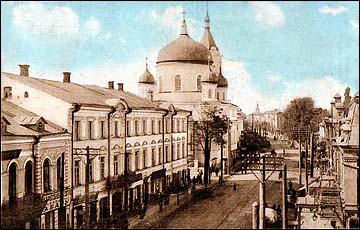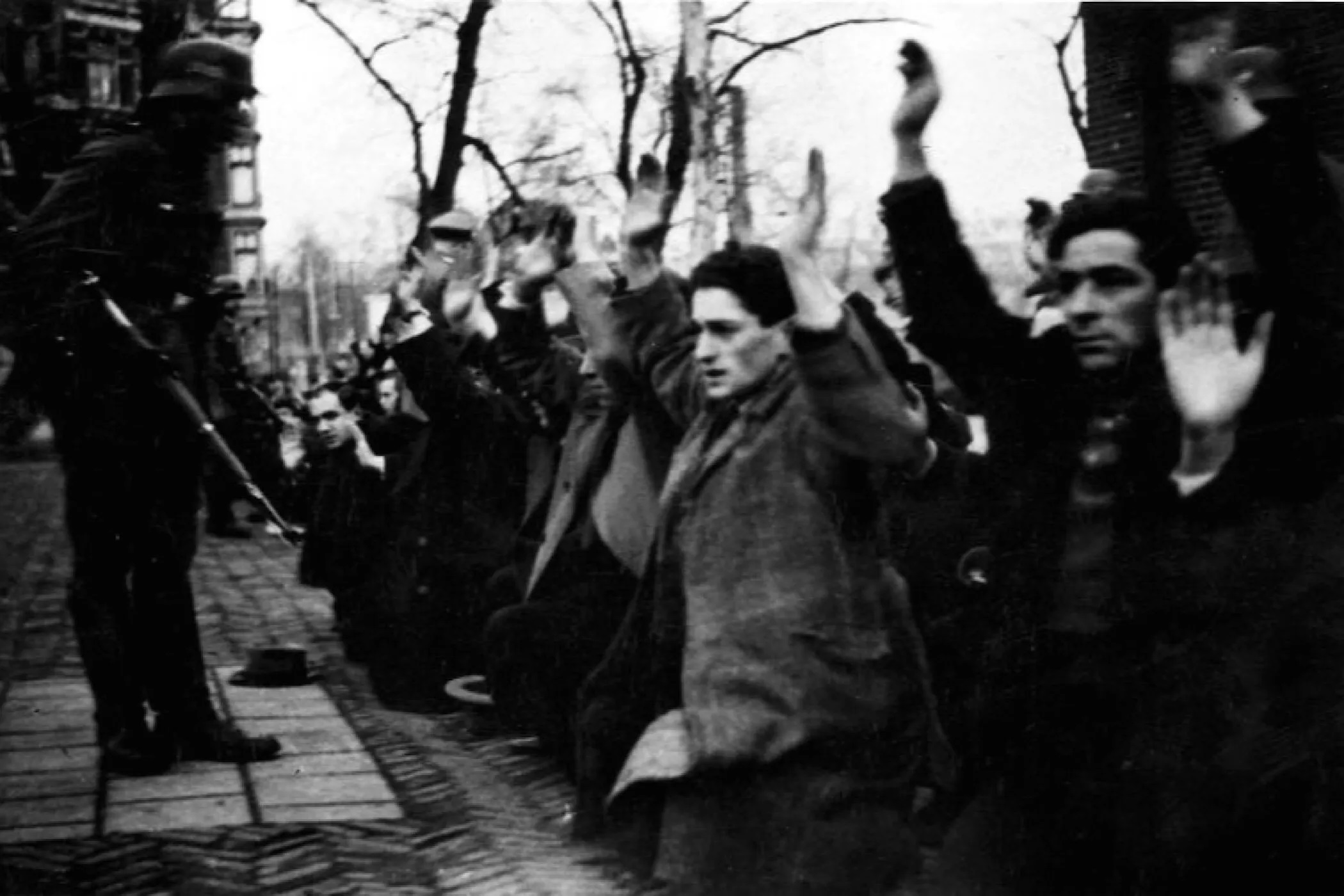|
Tadeusz Borowski
Tadeusz Borowski (; 12 November 1922 – 3 July 1951) was a Polish writer and journalist. His wartime poetry and stories dealing with his experiences as a prisoner at Auschwitz are recognized as classics of Polish literature. Early life Borowski was born in 1922 into the Polish community in Zhytomyr, Ukrainian SSR (today Ukraine). In 1926, his father, whose bookstore had been nationalized by the communists, was sent to a camp in the Gulag system in Russian Karelia because he had been a member of a Polish military organization during World War I. In 1930, Borowski's mother was deported to a settlement on the shores of the Yenisey, in Siberia, during Collectivization. During this time Tadeusz lived with his aunt. Borowski and his family were targeted (as Poles) by the Soviet Union during Stalin's Great Terror. In 1932, the Borowskis were expatriated to Poland by the Polish Red Cross in an exchange for Communist prisoners. Impoverished, the family settled in Warsaw. Experience ... [...More Info...] [...Related Items...] OR: [Wikipedia] [Google] [Baidu] |
Zhytomyr
Zhytomyr ( uk, Жито́мир, translit=Zhytomyr ; russian: Жито́мир, Zhitomir ; pl, Żytomierz ; yi, זשיטאָמיר, Zhitomir; german: Schytomyr ) is a city in the north of the western half of Ukraine. It is the Capital city, administrative center of Zhytomyr Oblast (Oblast, province), as well as the administrative center of the surrounding Zhytomyr Raion (Raion, district). The city of Zhytomyr is not a part of Zhytomyr Raion: the city itself is designated as its own separate raion within the oblast; moreover Zhytomyr consists of two so-called "raions in a city": Bohunskyi Raion and Koroliovskyi Raion (named in honour of Sergey Korolyov). Zhytomyr occupies an area of . Its population is Zhytomyr is a major transport hub. The city lies on a historic route linking the city of Kyiv with the west through Brest, Belarus, Brest. Today it links Warsaw with Kyiv, Minsk with Izmail, and several major cities of Ukraine. Zhytomyr was also the location of Ozerne (air base) ... [...More Info...] [...Related Items...] OR: [Wikipedia] [Google] [Baidu] |
Collectivization In The Soviet Union
The Soviet Union introduced the collectivization (russian: Коллективизация) of its agricultural sector between 1928 and 1940 during the ascension of Joseph Stalin. It began during and was part of the first five-year plan. The policy aimed to integrate individual landholdings and labour into collectively-controlled and state-controlled farms: ''Kolkhozes'' and ''Sovkhozes'' accordingly. The Soviet leadership confidently expected that the replacement of individual peasant farms by collective ones would immediately increase the food supply for the urban population, the supply of raw materials for the processing industry, and agricultural exports via state-imposed quotas on individuals working on collective farms. Planners regarded collectivization as the solution to the crisis of agricultural distribution (mainly in grain deliveries) that had developed from 1927. This problem became more acute as the Soviet Union pressed ahead with its ambitious industrializati ... [...More Info...] [...Related Items...] OR: [Wikipedia] [Google] [Baidu] |
Nazi Human Experimentation
Nazi human experimentation was a series of human experimentation, medical experiments on large numbers of prisoners, including children, by Nazi Germany in its Nazi concentration camps, concentration camps in the early to mid 1940s, during World War II and the Holocaust. Chief target populations included Romani people, Romani, Sinti, Poles, ethnic Poles, German mistreatment of Soviet prisoners of war, Soviet POWs, disabled Germans, and Jews from across Europe. List of Nazi doctors, Nazi physicians and their assistants forced prisoners into participating; they did not willingly volunteer and no consent was given for the procedures. Typically, the experiments were conducted without anesthesia and resulted in death, Trauma (medicine), trauma, disfigurement, or permanent disability, and as such are considered examples of medical torture. At Auschwitz concentration camp, Auschwitz and other camps, under the direction of Eduard Wirths, selected inmates were subjected to various exp ... [...More Info...] [...Related Items...] OR: [Wikipedia] [Google] [Baidu] |
Pneumonia
Pneumonia is an inflammatory condition of the lung primarily affecting the small air sacs known as alveoli. Symptoms typically include some combination of productive or dry cough, chest pain, fever, and difficulty breathing. The severity of the condition is variable. Pneumonia is usually caused by infection with viruses or bacteria, and less commonly by other microorganisms. Identifying the responsible pathogen can be difficult. Diagnosis is often based on symptoms and physical examination. Chest X-rays, blood tests, and culture of the sputum may help confirm the diagnosis. The disease may be classified by where it was acquired, such as community- or hospital-acquired or healthcare-associated pneumonia. Risk factors for pneumonia include cystic fibrosis, chronic obstructive pulmonary disease (COPD), sickle cell disease, asthma, diabetes, heart failure, a history of smoking, a poor ability to cough (such as following a stroke), and a weak immune system. Vaccines to ... [...More Info...] [...Related Items...] OR: [Wikipedia] [Google] [Baidu] |
Slave Labor
Slavery and enslavement are both the state and the condition of being a slave—someone forbidden to quit one's service for an enslaver, and who is treated by the enslaver as property. Slavery typically involves slaves being made to perform some form of work while also having their location or residence dictated by the enslaver. Many historical cases of enslavement occurred as a result of breaking the law, becoming indebted, or suffering a military defeat; other forms of slavery were instituted along demographic lines such as race. Slaves may be kept in bondage for life or for a fixed period of time, after which they would be granted freedom. Although slavery is usually involuntary and involves coercion, there are also cases where people voluntarily enter into slavery to pay a debt or earn money due to poverty Poverty is the state of having few material possessions or little income. Poverty can have d ... [...More Info...] [...Related Items...] OR: [Wikipedia] [Google] [Baidu] |
Auschwitz
Auschwitz concentration camp ( (); also or ) was a complex of over 40 concentration and extermination camps operated by Nazi Germany in occupied Poland (in a portion annexed into Germany in 1939) during World War II and the Holocaust. It consisted of Auschwitz I, the main camp (''Stammlager'') in Oświęcim; Auschwitz II-Birkenau, a concentration and extermination camp with gas chambers; Auschwitz III-Monowitz, a labor camp for the chemical conglomerate IG Farben; and dozens of subcamps. The camps became a major site of the Nazis' final solution to the Jewish question. After Germany sparked World War II by invading Poland in September 1939, the ''Schutzstaffel'' (SS) converted Auschwitz I, an army barracks, into a prisoner-of-war camp. The initial transport of political detainees to Auschwitz consisted almost solely of Poles for whom the camp was initially established. The bulk of inmates were Polish for the first two years. In May 1940, German criminals brought to t ... [...More Info...] [...Related Items...] OR: [Wikipedia] [Google] [Baidu] |
Pawiak
Pawiak () was a prison built in 1835 in Warsaw, Congress Poland. During the January 1863 Uprising, it served as a transfer camp for Poles sentenced by Imperial Russia to deportation to Siberia. During the World War II German occupation of Poland, it was used by the Germans, and in 1944 it was destroyed in the Warsaw Uprising. History Pawiak Prison took its name from that of the street on which it stood, ''ulica Pawia'' (Polish for "Peacock Street"). Pawiak Prison was built in 1829–35 to the design of Enrico Marconi and Fryderyk Florian Skarbek, prison reformer and godfather to composer Frédéric Chopin. During the 19th century, it was under tsarist control as Warsaw was part of the Russian Empire. During that time, it was the main prison of central Poland, where political prisoners and criminals alike were incarcerated. During the January 1863 Uprising, the prison served as a transfer camp for Poles sentenced by Imperial Russia to deportation to Siberia. After Po ... [...More Info...] [...Related Items...] OR: [Wikipedia] [Google] [Baidu] |
Gestapo
The (), abbreviated Gestapo (; ), was the official secret police of Nazi Germany and in German-occupied Europe. The force was created by Hermann Göring in 1933 by combining the various political police agencies of Prussia into one organisation. On 20 April 1934, oversight of the Gestapo passed to the head of the ''Schutzstaffel'' (SS), Heinrich Himmler, who was also appointed Chief of German Police by Hitler in 1936. Instead of being exclusively a Prussian state agency, the Gestapo became a national one as a sub-office of the (SiPo; Security Police). From 27 September 1939, it was administered by the Reich Security Main Office (RSHA). It became known as (Dept) 4 of the RSHA and was considered a sister organisation to the (SD; Security Service). During World War II, the Gestapo played a key role in the Holocaust. After the war ended, the Gestapo was declared a criminal organisation by the International Military Tribunal (IMT) at the Nuremberg trials. History After Adol ... [...More Info...] [...Related Items...] OR: [Wikipedia] [Google] [Baidu] |
Warsaw University
The University of Warsaw ( pl, Uniwersytet Warszawski, la, Universitas Varsoviensis) is a public university in Warsaw, Poland. Established in 1816, it is the largest institution of higher learning in the country offering 37 different fields of study as well as 100 specializations in humanities, technical, and the natural sciences. The University of Warsaw consists of 126 buildings and educational complexes with over 18 faculties: biology, chemistry, journalism and political science, philosophy and sociology, physics, geography and regional studies, geology, history, applied linguistics and philology, Polish language, pedagogy, economics, law and public administration, psychology, applied social sciences, management and mathematics, computer science and mechanics. The University of Warsaw is one of the top Polish universities. It was ranked by '' Perspektywy'' magazine as best Polish university in 2010, 2011, 2014, and 2016. International rankings such as ARWU and University We ... [...More Info...] [...Related Items...] OR: [Wikipedia] [Google] [Baidu] |
Roundup (history)
A roundup is a police operation of interpellation and arrest of people taken at random from a public place, or targeting a particular population by ethnicity, appearance, or other perceived membership in a targeted group. To ensure operational success, organizers rely on the element of surprise in order to reduce the risk of evasion as much as possible. When the operation involves large numbers of individuals not targeted for any perceived group membership, it may be called a mass arrest. Roma in Europe Spanish Monarchy The Great Gypsy Round-up was a raid authorized and organized by the Spanish Monarchy that led to the arrest of all gypsies (Romani) in the region, and their imprisonment in labor camps. The raid was approved by King Ferdinand VI of Spain, was organized by the Marquis of Ensenada, and was set in motion simultaneously across Spain on 30 July 1749. World War II Belgium The Jewish population of Belgium was rounded up four times during the Second ... [...More Info...] [...Related Items...] OR: [Wikipedia] [Google] [Baidu] |
Underground Education In Poland During World War II
World War II saw the cultivation of underground education in Poland ( pl, Tajne szkolnictwo, or '). Secretly conducted education prepared scholars and workers for the postwar reconstruction of Poland and countered German and Soviet threats to eradicate Polish culture. Background: repressions of Polish education After the Polish defeat in the invasion of Poland of 1939 and the subsequent German and Soviet occupation of Polish territory, Poland was divided into the areas directly incorporated into the Reich, areas directly incorporated into the Soviet Union and the German-controlled General Government. According to Nazi racial theories the Slavs needed no higher education and the whole nation was to be turned into uneducated serfs for the German race. The only schools that remained opened were trade schools and courses for factory workers. [...More Info...] [...Related Items...] OR: [Wikipedia] [Google] [Baidu] |


.jpg)




